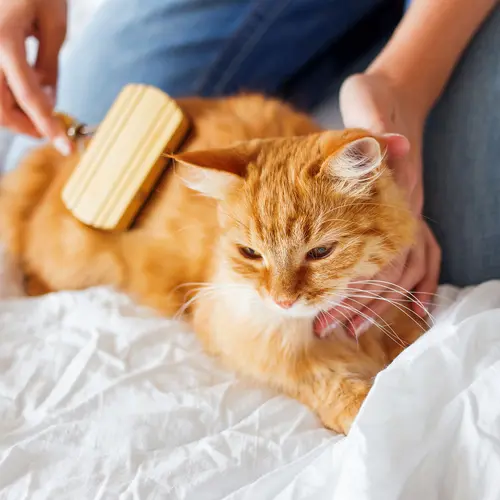Cats are carnivores, which means they eat mostly meat. House cats evolved from hunters who ate high amounts of protein and some fat and carbohydrates. They still need the same type of diet today.
Cat Diet
Cats need meat — you shouldn't feed them a vegetarian diet. They also need a good balance of fat, carbohydrates, vitamins, minerals, fatty acids, and amino acids, which are building blocks for protein. Cats' dietary needs change with age and health.
Kitten diet. Kittens need their mother’s milk from birth until they are 6-8 weeks old. Once weaning starts, they need high amounts of protein. As kittens grow, the amount of protein they need will steadily drop. Kittens also need calcium as well as fats for energy and fat-soluble vitamins.
You can start weaning kittens onto wet food at 3-4 weeks. You can start to introduce dry food at 6 weeks, but the main food should be wet food that is high in protein.
Adult cat diet. Adult cats need a balanced diet for healthy tissues and body systems. A diet of 50-60% protein and 30-50% fat is usually a good balance. If your cat isn’t very active, your vet might suggest different amounts. One of the most important parts of a cat diet is access to plenty of fresh, clean water.
Most cats don't just eat one meal a day. Plenty of cats can be "free-fed" or have multiple meals. The most important thing is the amount of calories consumed, not the number of times they eat. It is important for senior cats 7 and older to maintain a balanced diet. Sometimes cats have health conditions like diabetes or hyperthyroidism, which involves the overproduction of thyroid hormones, that can cause undereating or overeating. This condition can be treated so that your cat will return to eating normally.
Senior cat diet. There are no specific nutrition guidelines for senior cats. A senior diet usually starts around age 7, but it’s best to talk to your vet and set up a diet that suits your cat’s health.
There are lots of types of cat food. The most important factor in choosing the best food is reading the labels and making sure the type of food is balanced with the right amount of nutrients. The Association of American Feed Control Officials (AAFCO) sets standards for the nutrient profiles of pet foods that pets need at particular life stages.
Dry food. Dry food is made of a mixture of meat and meat byproducts, grain, vitamins, minerals, poultry and poultry byproducts, and fish meal. This mixture is dried into small bite sizes and is often coated in fat, which helps with taste. Sometimes, though, cats don’t like dry food and don’t digest it very well.
Semi-moist food. Semi-moist food is made mostly of meat and meat byproducts with some fillers and preservatives added. This type of food has more moisture and might be tastier for cats. Once the package is opened, though, the food can dry out, harden, and spoil.
Canned food. Canned cat food contains a variety of meats, meat by-products, vegetables or grains. It has high moisture and is a good food source of water for your cat. It’s much tastier for your cat, but some brands may not have all the nutrition your cat needs. Canned cat food should be kept in the fridge once it's opened.
Homemade food. You may want to make your own cat food, but this is generally not recommended unless your vet tells you this is the best option. Homemade food often doesn’t have the right balance of proteins, fats, carbohydrates, vitamins and minerals.
Treats. It’s OK to give your cat occasional treats. Raw meat and canned fish for humans are not recommended because cats can get sick from eating these foods. It’s also best not to feed your cat milk because cats can be lactose-intolerant.
What to Do if Your Cat Won’t Eat
Sometimes cats can be picky about where they eat and the type of food they enjoy, and they may not eat what you're feeding them. This can be normal behavior, and a few simple changes can help. These might include:
- Moving food dishes away from litter boxes or dirty food containers
- Moving food dishes out of busy areas
- Feeding your cat away from other animals
Timed Feeding. You might feel that you should be tough and hold out for your cat to get hungry enough to eat. However, this can be hard on your cat’s body and could cause them to get sick. Instead, try setting out smaller amounts for 15 to 30 minutes at a time four to five times during the day. As your cat eats more, you can move back to one to leaving food out for free feeding.
Picky eaters. If your cat is picky about eating, try rotating between two or three different foods. This will give a variety of flavors that can keep your cat from becoming a picky eater. Changing the brand occasionally might also help with variety. Make sure to choose one that meets your cat’s nutrition needs.
Refusing food. If your cat suddenly stops eating, this can be a sign of illness. It’s best to take your cat to the vet to rule out any problems.


